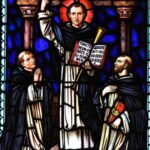
St. Junipero Serra
St. Junipero Serra
St. Junipero Serra – A Historical Overview
When They Lived:
St. Junipero Serra lived from November 24, 1713, to August 28, 1784.
Where They Lived:
St. Junipero Serra lived in various locations across Spain and the Americas, most notably in Mallorca, Mexico, and California.
Notable World Events During Their Time:
- Seven Years’ War (1756-1763): This global conflict involving major European powers also had repercussions in the Americas, influencing territorial control and trade dynamics.
- American Revolution (1775-1783): The American colonies fought for independence from British rule, impacting the geopolitical landscape and inspiring ideas of liberty and self-determination.
- Industrial Revolution: The 18th century marked the beginning of the Industrial Revolution, characterized by advancements in manufacturing, transportation, and technology that transformed societies worldwide.
- Captain James Cook’s Voyages: Explorer Captain Cook’s voyages to the Pacific in the 1760s and 1770s revealed new lands, cultures, and scientific findings, expanding the world’s knowledge and inspiring further exploration.
- Enlightenment Era: The Enlightenment was a period of intellectual and philosophical development, promoting reason, individualism, and scientific inquiry, which laid the foundation for societal changes and modern thought.
- Benjamin Franklin’s Experiments: The pioneering experiments of Benjamin Franklin during this time contributed to a better understanding of electricity and lightning, fostering scientific progress.
- French Revolution (1789-1799): The French Revolution, beginning shortly after St. Junipero Serra’s death, marked a significant shift in political ideology, leading to widespread changes in France and beyond.
Patronage:
St. Junipero Serra is known as the patron saint of vocations, particularly those related to mission work and evangelization. He is also considered a patron of Hispanic Americans and indigenous peoples of the Americas, as he played a key role in establishing missions that had a lasting impact on these communities. His dedication to spreading Christianity and his contributions to the establishment of missions in California make him an inspiring figure for those seeking to bring positive change and spiritual guidance to diverse populations.
Early Life
Junipero Serra was born Miguel Joseph Serra I Ferrer on November 14, 1713, on Mallorca, an island off the Spanish coast. His parents, Antonio Nadal Serra and Margarita Rosa Ferrer, were wheat and bean farmers.
From an early age, Serra knew that the Catholic Faith was of great importance and would often visit the friars at the Franciscan Order. At the age of 15, Serra enrolled in a Franciscan school in the capital city, Palma de Majorca, and a year later, at the age of 16, he became anovice of the Franciscan order.
Serra took the name Junipero, a brother companion of St. Francis, when he took his first vows in 1731, and by 1737, he was ordained as a priest in the Franciscan order. Although Serra showed remarkable promise as a scholar and professor, he realized that his true calling lay in missionary work after reading about St. Francis Solanus, a brave South American missionary.
This discovery led him to a life in North America, never to return home again.
Life in North America
Serra’s journey to North America started in 1748, and he arrived in Veracruz on the Gulf Coast of New Spain, now known as New Mexico, in 1749, before traveling 250 miles by foot to their destination of Mexico City. Serra spent less than six months at the College of San Fernando before joining the volunteers for the Sierra Gorda missions and beginning to build a reputation as an advocate for the natives through his generous and loving response to the needs of the poor and vulnerable in his charge.
He went on to spend eight years with the Pame Indians. During his apostolate with them, he ensured the construction of a church and developed his mission in religious and economic directions. Through his zealous preaching, he brought the Pame people to practice the faith. In 1758, Serra returned to the College of San Fernando but continued his calling as a missionary, preaching in numerous cities and becoming president of missions in California.

Establishing his headquarters in Mission San Carlos Borromeo in Carmel,Serra started receiving natives into the Church. Conversion to the faith was not a requirement.
As an outspoken defender of their human rights, Serra was fearless in calling out the government for its abuse of them. Through the rising tensions, Serra visited Mexico City to promote a mission that focused on the salvation of souls over domination and conquest, and the rules that he presented during his visit would later serve as the basis for the first major laws of California.
Serra volunteered himself to join an expedition to Upper California. On his way to San Diego, he founded his first mission at San Fernando de Velicata in 1769 and pledged the next fifteen years of his life to evangelical work in Upper California.
At the End
St. Junipero Serra died a peaceful death at the age of 70 after a life spent in devotion to God in 1784 at his home at the Carmel Mission. He was buried on the floor of the Church that he had built.
By the end of 1784, 6,736 Indians had been baptized at the nine missions Serra had established, while 4,646 Christianized Indians called the missions home.
In character, Serra was described as being eager, optimistic, zealous, and passionate about his faith and way of preaching, and he fought endlessly for the freedom of the Church against royal infringement.
Canonization
Junipero Serra became the first American saint of Hispanic origin to be canonized in 2015 when Pope Francis declared him a saint on a trip to Washington, DC. This historic declaration formed part of the Pope’s first visit to the States and was the first canonization of Americans.
The Patronage and Veneration of Junipero Serra
Saint Junipero Serra is the patron saint of vocations to Church ministry in California, where he was instrumental in building the Church on the west coast of America.
On the day Junipero Serra was canonized, Pope Francis described him as a special patron of Hispanic Americans.
In 1988, Serra was honored by Pope John Paul II when he declared him blessed and beatified. Junipero Serra is described as a Catholic leader worthy of veneration and devotion.
Today, various institutes and organizations carry Saint Junipero Serra as their patron saint, with his exemplary example of missionary zeal and passion for the Gospel at the root of their missions and teachings.
Numerous statues and memorials have been built to celebrate this place in American history.
5 Interesting Facts About St. Junipero Serra
- Serra was baptized on the same day he was born because he was sick.
and not believed to live for a long time, and his two older
siblings hadn’t survived childhood. - While Junipero Serra was an outspoken advocate for the rights of the
Indians, he believed in corporal punishment when the rules were
broken. - Serra thought of himself as a “sinner” and “most unworthy.
priest.” - To purify his spirit, Junipero Serra would punish himself.
physically.
Prayer to St. Junipero Serra
O God, in Your ineffable mercy, You chose Saint Junipero Serra as a means of gathering many peoples of the Americas into Your Church. Grant that through his intercession our hearts may be united in You in ever greater love, so that at all times and in all places we may show forth the image of Your Only-Begotten Son, our Lord Jesus Christ, who lives and reigns with You in the unity of the Holy Spirit, one God, forever and ever. Amen.



